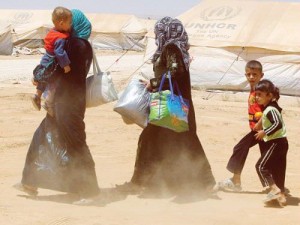 The UN has launched the largest emergency appeal in its history, requesting $4.4bn to deal with a deteriorating humanitarian crisis in Syria. But with the number of refugees increase faster than estimated, there are fears the money will be insufficient.
The UN has launched the largest emergency appeal in its history, requesting $4.4bn to deal with a deteriorating humanitarian crisis in Syria. But with the number of refugees increase faster than estimated, there are fears the money will be insufficient.
“Unfortunately, several of the former appeals for the humanitarian response inside Syria and in neighbouring countries have underestimated the scale of the crisis,” said Toril Brekke, acting secretary general of the Norwegian Refugee Council.
The Syria crisis is the fastest growing refugee crisis in the world. More than 80,000 people have been killed in the three-year conflct in which hospitals, schools and water and sanitation infrastructure have been targeted. The humanitarian situation has escalated rapdily since last year. From 1 million people needing humanitarian assistance in April last year, the number stands at 6.8 million as of this April. This includes 4.25 million Syrians who are internally displaced and more than 1.6 million refugees, concentrated in Jordan, Lebanon and Turkey. The number of people in need is expected to rise to 10 million by the end of the year.
“We are witnessing the daily human wreckage of a country tearing itself apart,” said Jane Cocking, humanitarian director of Oxfam. “Our common humanity implores us to respond to the suffering of millions of Syrians caught up in an unremitting tragedy. Even in harsh economic times there can be no excuses for governments to shirk from their duty to dig deep and generously fund the aid effort. They cannot look the other way. This is the world’s most pressing humanitarian crisis.”
The lack of funding has posed serious problems. In Zaatari camp, Jordan, there are two schools running with 10,000 children attending. However, there are about 30,000 children of school age at the camp. A third school is being built that will be able to accommodate 5,000 children. However, there is no money to keep it running, no money for teachers’ salaries and furniture.
Heavy fighting in the central Syrian town of Qusair, which was captured by government forces, supported by the Lebanese Shia militia Hezbollah, has sparked another wave of displacement. The UN estimates that 40,000 fled the town last month to the Hasiya area, about 25km from Qusair.
The humanitarian situation in Hasiya was described by the UN as dire, with many families sheltering in three schools and in various unfinished buildings and makeshift tents. Many displaced children suffer from diarrhoea, respiratory infections, high fever, ear infections and skin diseases, due to poor sanitation and hygiene.
In April, the heads of five major UN agencies issued a rare joint appeal to the international community to do much more to end “cruelty and carnage” in Syria. The heads of the World Health Organisation, Unicef, the Office for the Co-ordination of Humanitarian Affairs, the World Food Programme and the UNHCR, the UN refugee agency, urged political leaders to use their influence to solve the crisis and criticised what they described as “an insufficient sense of urgency among the governments and parties that could put a stop to the cruelty and carnage in Syria”.
On Thursday, the British government hosted a meeting in London of the core of the Friends of Syria group to discuss preparations for the Geneva II peace conference, which has been postponed until at least July because of difficulties in convening it.
The Syrian government has said it will attend the peace conference. However, the opposition is in disarray, divided over whether to take part in any negotiations while Assad’s departure is not recognised as a precondition. Western diplomats acknowledge that the capture of Qusair is likely to have emboldened President Bashar al-Assad, making him less likely to consider concessions – let alone stepping down.
The UN appeal for Syria dwarfs past emergency requests such as those for the 2011 Horn of Africa food crisis ($2.5bn), the 2010 Haiti earthquake ($1.5bn), and the 2004 Indian Ocean tsunami ($1.28bn).
The Guardian
Leave a Reply
You must be logged in to post a comment.